
Court halts tailings increase as First Nation challenges B.C.’s decision to greenlight it
Court sides with Xatśūll First Nation, temporarily halting Mount Polley mine waste expansion
The spotted owlet lay in his incubator, refusing bits of rat muscle offered on tweezers. If he survived he would soon grow enough fluff to put a poodle to shame. But right now his skin had the texture of a plucked chicken and a few errant white feathers stuck up at odd angles, making him one of the most pathetic-looking creatures biologist Jasmine McCulligh had ever seen.
McCulligh had worked non-stop for four days in a row at the B.C. government-funded Northern Spotted Owl Breeding Program in Langley. She was on call while the owlet hatched over 85 hours in a lab called Artificial Inc., as a playlist of spotted owl calls and forest bird song rolled in the background. Now she lay on the laboratory floor, exhausted. The one-day old owlet crumpled in his plastic tray, crying.
McCulligh knew the breeding centre could not afford to lose this newborn. At that point in time, in April 2017, there were only six spotted owls left in B.C.’s wild, even though scientists had been sounding the alarm for decades about widespread destruction of the species’ ancient rainforest habitat.
Ten years into operation, the breeding centre had hatched just eight other spotted owls — and one was blind, couldn’t fly and laid eggs in her water dish. “It was the most stressful thing of my entire life,” McCulligh remembered. “It was at the point where I just didn’t know what to do anymore.”
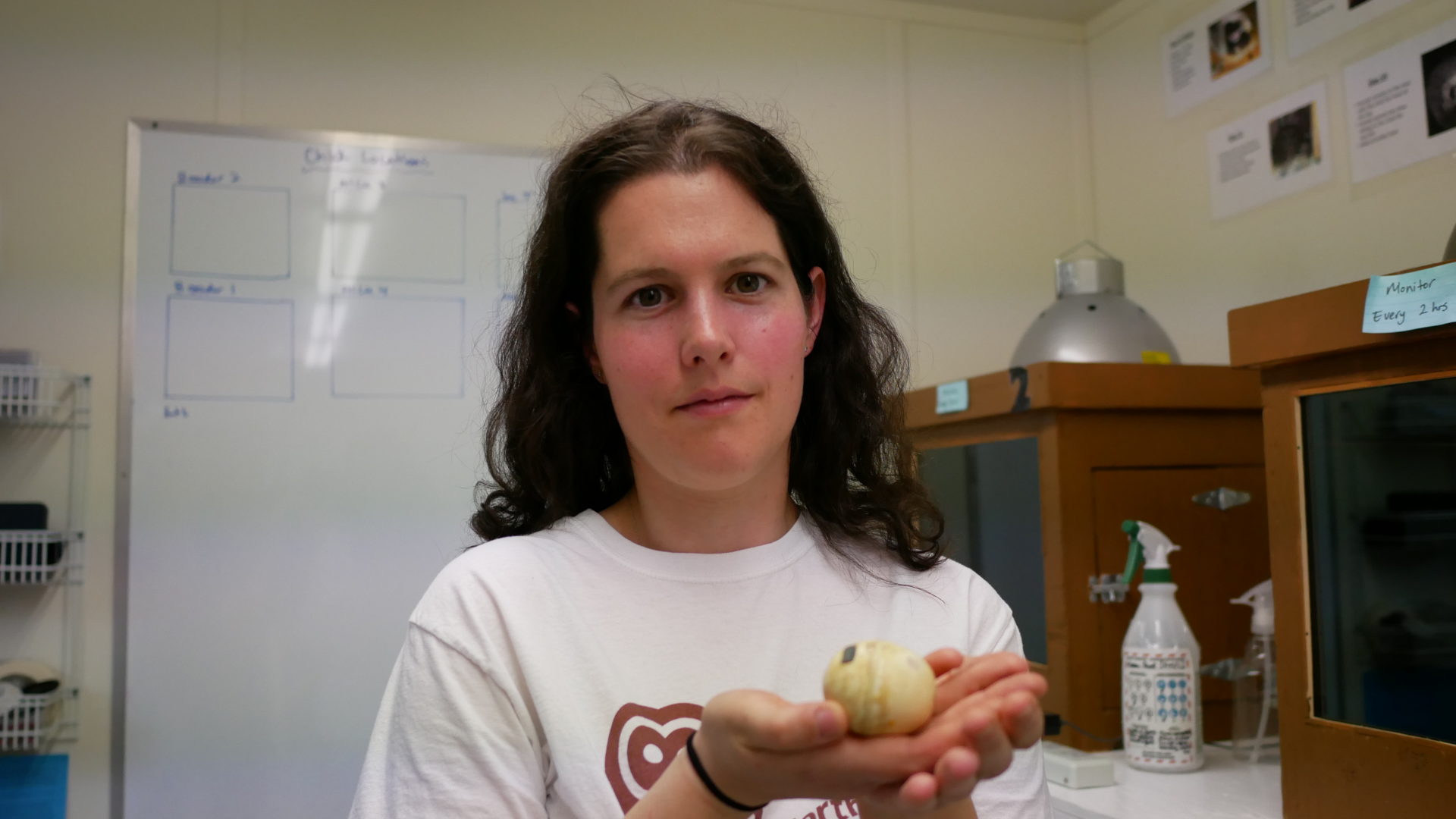
Jasmine McCulligh, biologist with the Northern Spotted Owl Breeding Centre, holds an artificial egg used to gather data in the nests of breeding pairs. Photo: Carol Linnitt / The Narwhal
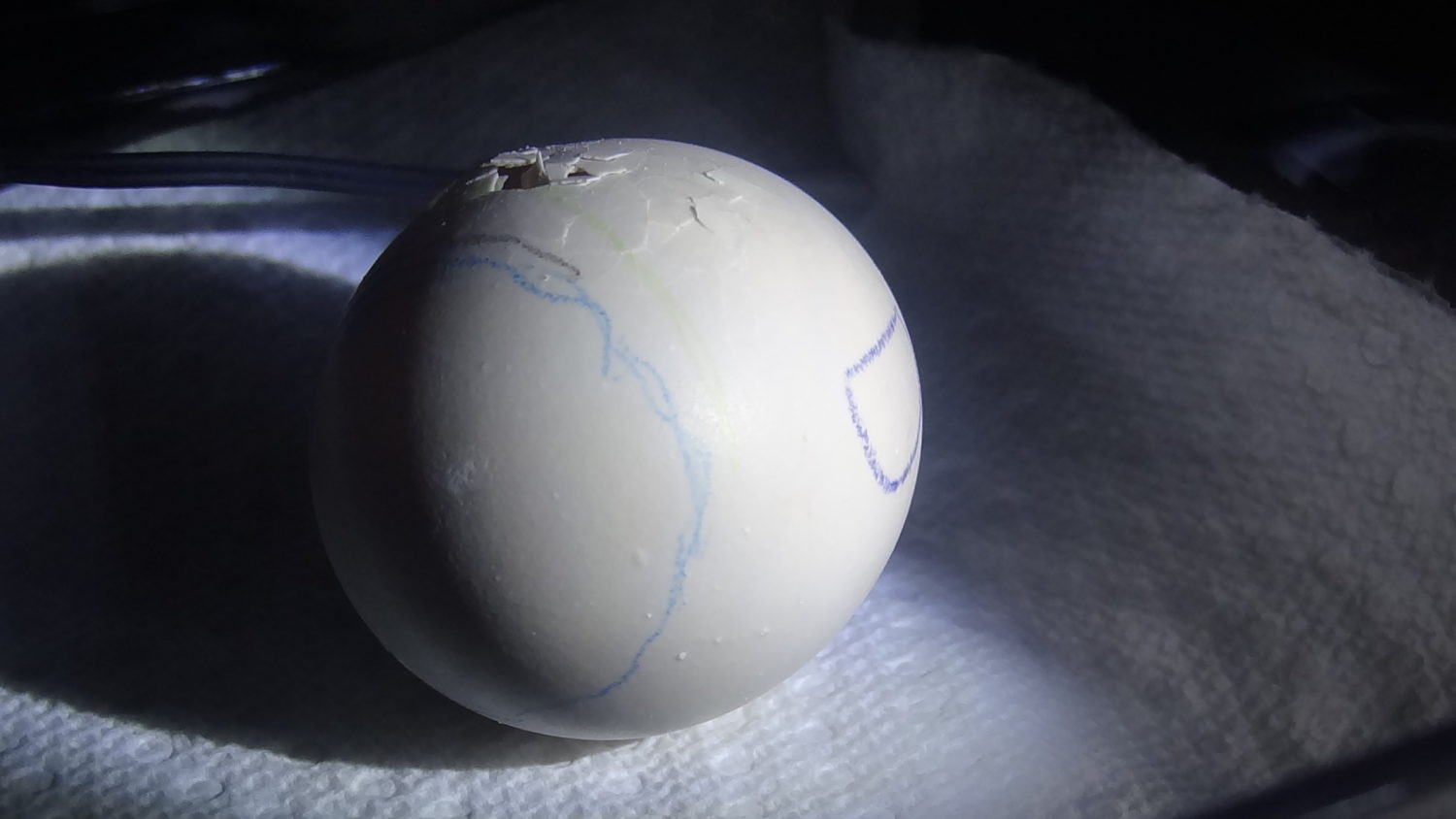
A spotted owl hatching known as D-17. Photo: Northern Spotted Owl Breeding Program
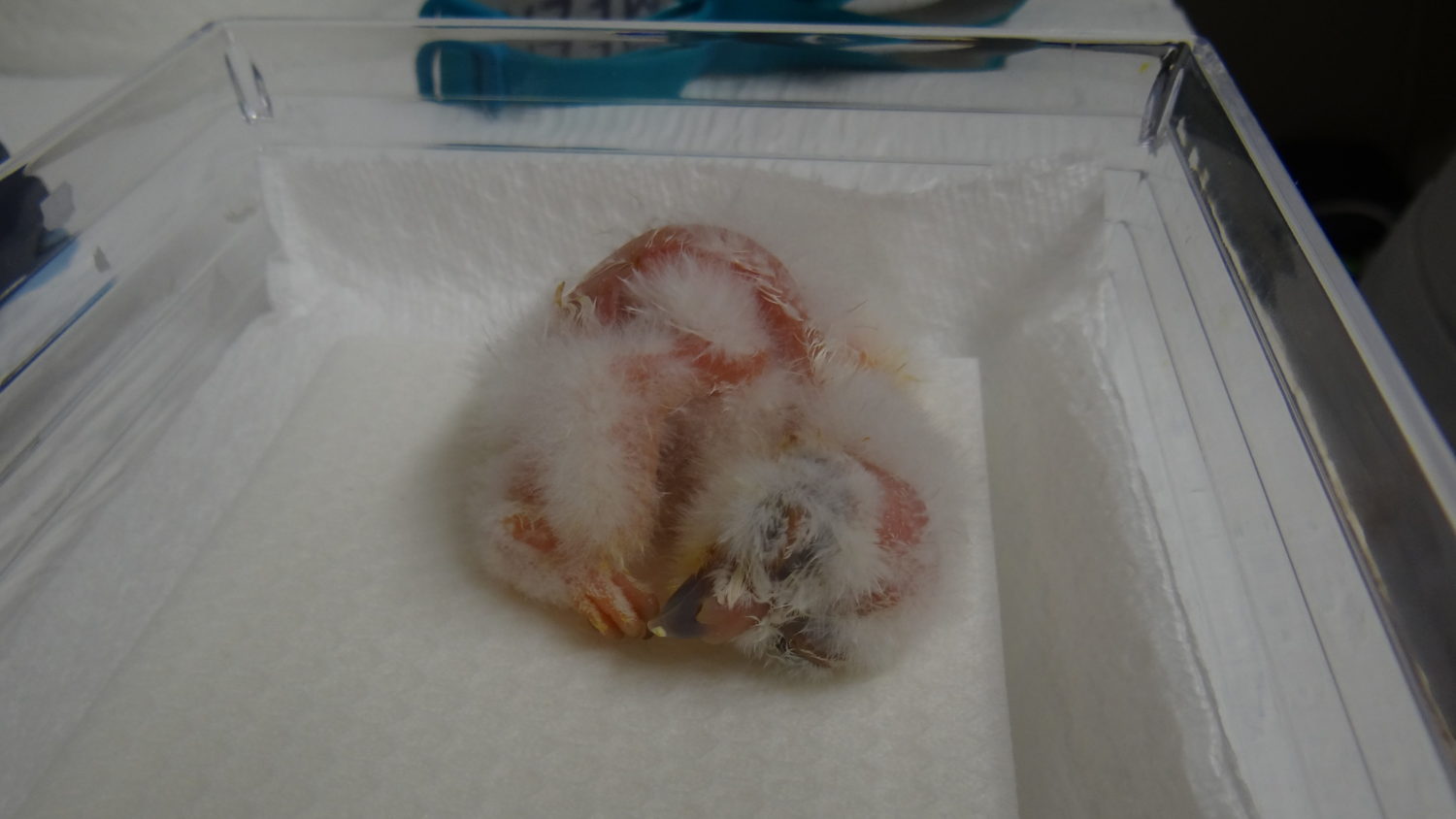
D-17 at 12 days old. Photo: Northern Spotted Owl Breeding Program
Raising endangered spotted owls at the world’s only breeding centre for the species is part science and part educated guesswork, and takes deep pockets as well as conviction. It’s not as though biologists can google the correct antibiotic dose for an ailing chick or flip through a textbook to learn how to improve egg fertility. And then there’s the unanswered question of why spotted owls in captivity take so long to have sex. One male and female at the centre shared an aviary for four years before they mated.
“We’ve had to learn everything,” said McCulligh, the breeding centre’s multi-tasking coordinator and spotted owl specialist. “It’s been a huge, steep learning curve trying to figure out the best possible way to take care of the species here. We’ve learned that the spotted owl is so unique and special that it has specific requirements.”
Spotted owls rose from obscurity to distinction in the 1980s and 1990s and became a symbol of the destruction of ancient rainforests in the Pacific Northwest. In the U.S., debate and lawsuits raged over logging in the owl’s habitat and mill towns famously sold t-shirts and bumper stickers with the slogan, “Save a Logger, Eat an Owl.”
Logging was halted in old-growth Pacific Northwest forests in the early 1990s after the owl was listed under the broad-reaching U.S. Endangered Species Act. But the species has continued to decline in the U.S., in large part because so much of its habitat was already destroyed and because the barred owl, an invading bigger cousin, is moving into spotted owl territories.
In Canada, a legally mandated federal recovery strategy released in 2006 has been an abysmal failure. Spotted owls are now functionally extinct in Canada’s wild, where an estimated 1,000 of the raptors once lived in southwestern B.C.’s old-growth forests of Douglas fir, western hemlock and western red cedar. For 12 years, the B.C. government has steadfastly avoided identification of the owl’s critical habitat, required by the recovery strategy. This year, a full-time B.C. government spotted owl biologist detected only three spotted owl individuals in the Canadian wild, all in the Fraser Canyon. He found no breeding pairs.
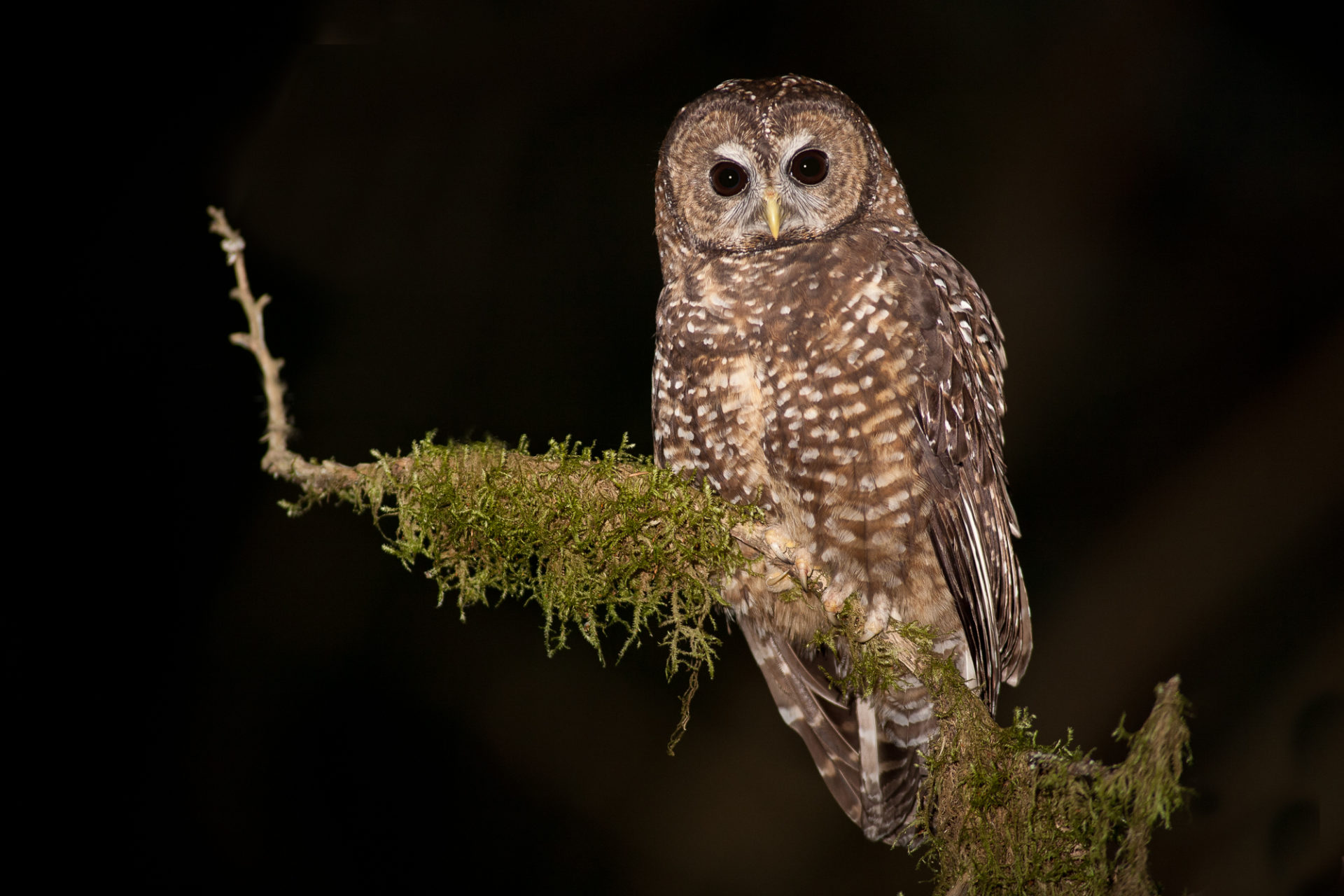
A Northern Spotted Owl, strix occidentalis caurina, in southern B.C. Photo: Jared Hobbs
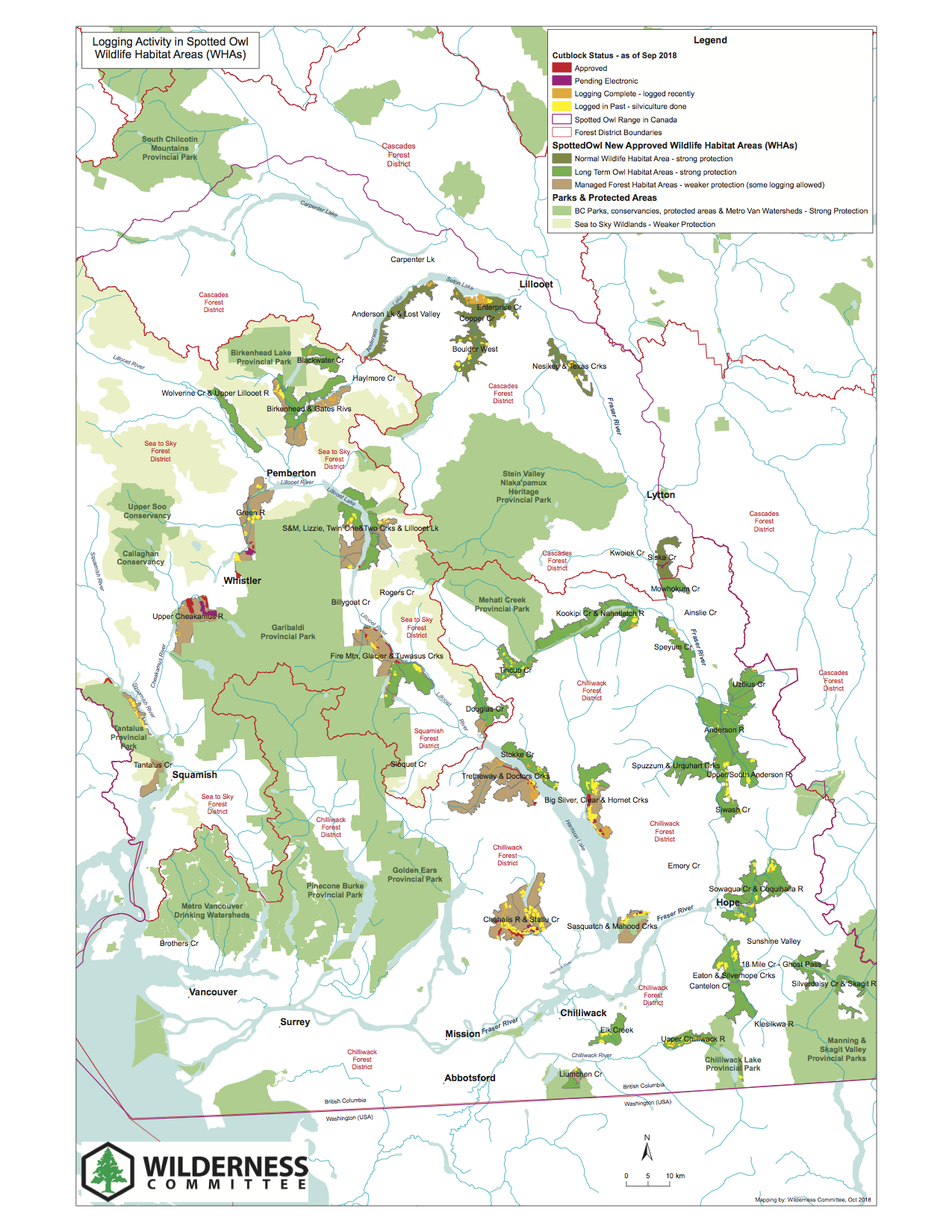
Map of logging in spotted owl habitat. B.C. has approved clear-cut logging in areas it set aside for spotted owl recovery at the same time as committing nearly $1.5 million to the experimental captive breeding program since 2014. Map: Wilderness Committee
The decimation of B.C.’s spotted owl population has scientists on both sides of the border asking tough questions about how we manage the 600 species legally protected under Canada’s
Species at Risk Act. From feeding and medicating an ailing orca whale near Victoria to sedating pregnant caribou and flying them in helicopters to a breeding pen high in the Misinchinka mountains in northeast B.C., substantial amounts of money are being spent on increasingly complex efforts to recover endangered species while governments quietly sanction destruction of their habitat. The B.C. government, for instance, has approved clear-cut logging in areas it set aside for spotted owl recovery, while sinking almost $1.5 million into the experimental captive breeding program since 2014.
“The species is now circling the drain,” said U.S. conservation scientist Dominick DellaSala, who has worked on spotted owls as part his global work in rainforests. “We’ve got to get to the point where we’re not in the critical care unit of a hospital where the patient, in this case the owl, is on life support.”
As a postdoctoral student, DellaSala hiked through old-growth rainforests in the Pacific northwest, hooting in the hopes of getting a call back from a spotted owl, assessing the species’ habitat needs and prey base “so we could do something about the owl before it got to the situation we’re in today.”
“We’ve put them in the ICU of captive breeding,” DellaSala told The Narwhal. “And when we have put a species in that situation, just like putting a person in ICU, you run the risk that it isn’t going to work. You’re down to the last few individuals and you can’t really make a mistake because [if you do] that’s it, it’s gone.”
Pulling out every stop to save the ailing hatchling, McCulligh called in a veterinarian, who diagnosed an infection and prescribed antibiotics. But nobody knew the correct dose for a spotted owlet that weighed half as much as a tennis ball and could fit in a teacup with room to spare, so they gave him diluted antibiotics drops. “You can’t do an intramuscular injection on something that doesn’t have muscle,” McCulligh said. “We’d give him a little drop and he hated it. You could tell he’d got it in his system.”
The owl survived with around the clock intensive care. Once he could swallow muscle, he was hand-fed pieces of rat organ meat and later, when he could regurgitate a pellet, rodent bones and fur. Today, the 18 month-old owl lives in a spacious aviary at the breeding centre, which houses 20 other spotted owls, including three from the U.S. and eight individuals brought in from the wild by B.C. government biologists to boost the breeding stock, as well as one owl hit by a car.
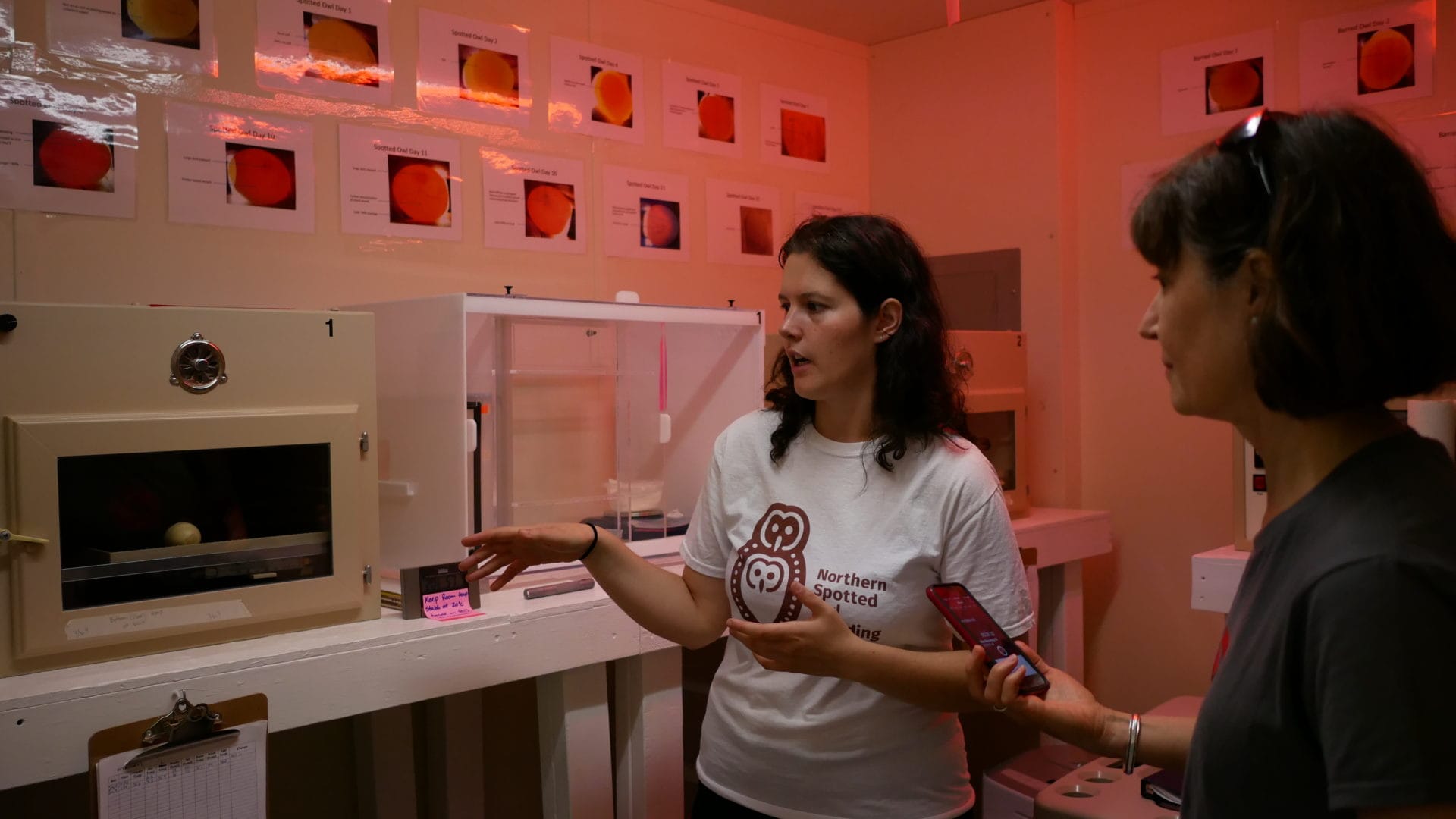
McCulligh describes the intensive incubation process for spotted owls. Photo: Carol Linnitt / The Narwhal
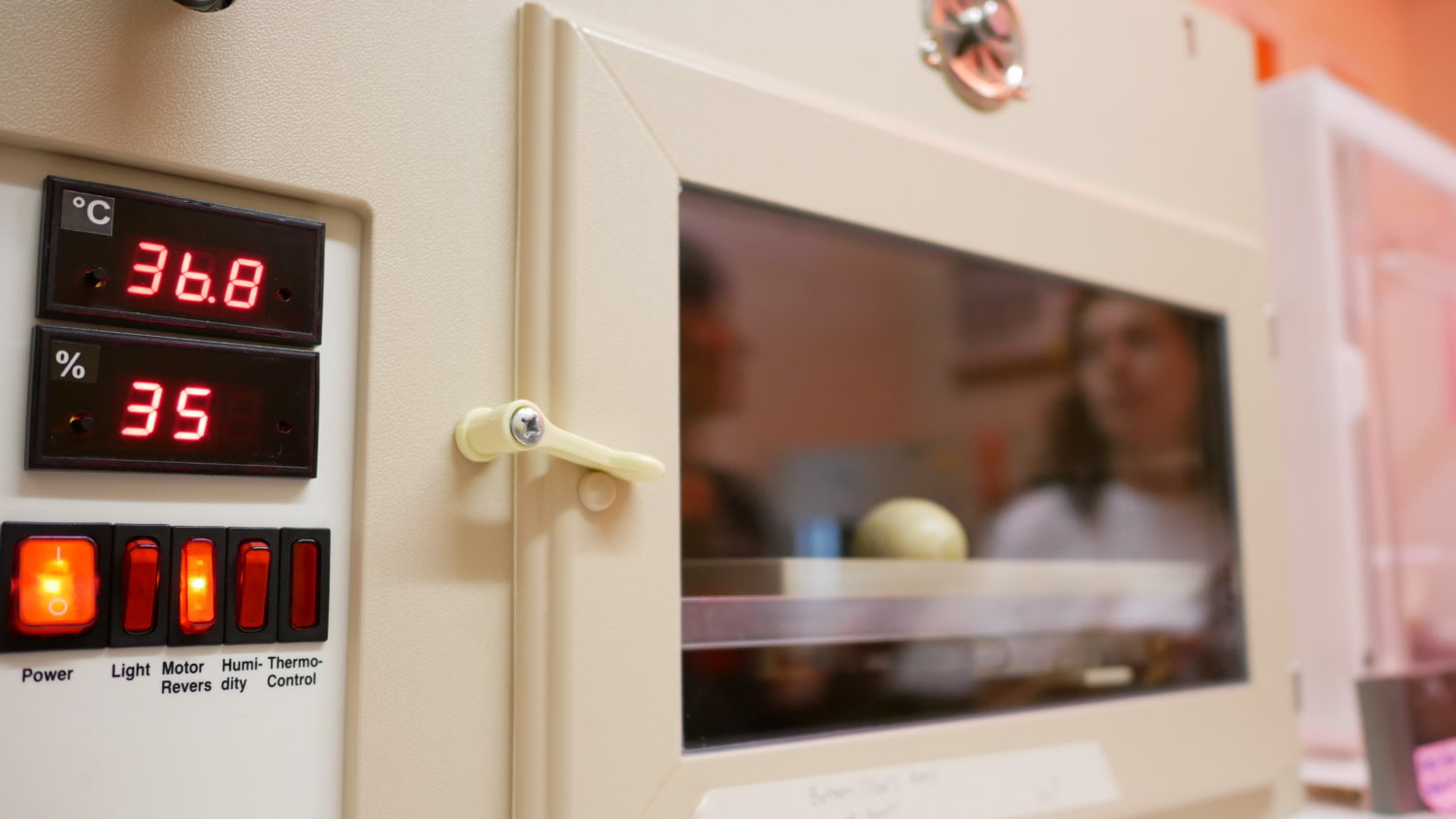
Temperature controlled incubator where owl eggs are incubated for 32 days. Breeding centre staff began artificially incubating eggs after some were broken and consumed by captive females. Photo: Carol Linnitt / The Narwhal
The ugly duckling has become a beautiful raptor, with chocolate brown eyes, a heart-shaped facial disc and dark feathers bejeweled with creamy white spots. A retinue of biologists and technicians monitor his health and progress. Each late afternoon — at dusk during breeding season — two grain-fed euthanized mice or one euthanized juvenile rat are delivered to his feeding platform.
The owl was named Dante, which means enduring. “He’s a little champ now,” McCulligh said. “I get goosebumps thinking of it. One of my proudest moments was to see this chick get better.”
I first met McCulligh at a fundraiser for the spotted owl breeding centre. It was one of a number of fundraisers — including document shredding and Adopt-an-Owl and Adopt-an-Egg programs — that she and other recovery centre staff and volunteers organize each year to supplement government funding for the centre. (The centre’s 2018 budget is $362,000, with $270,000 in direct funding from the B.C. government.)
I’d been trying to reach the B.C. government manager in charge of the breeding program to get permission for a breeding centre visit and ask about the status of spotted owls after the B.C. government announced its 2006 plan to protect them from Canadian extinction.
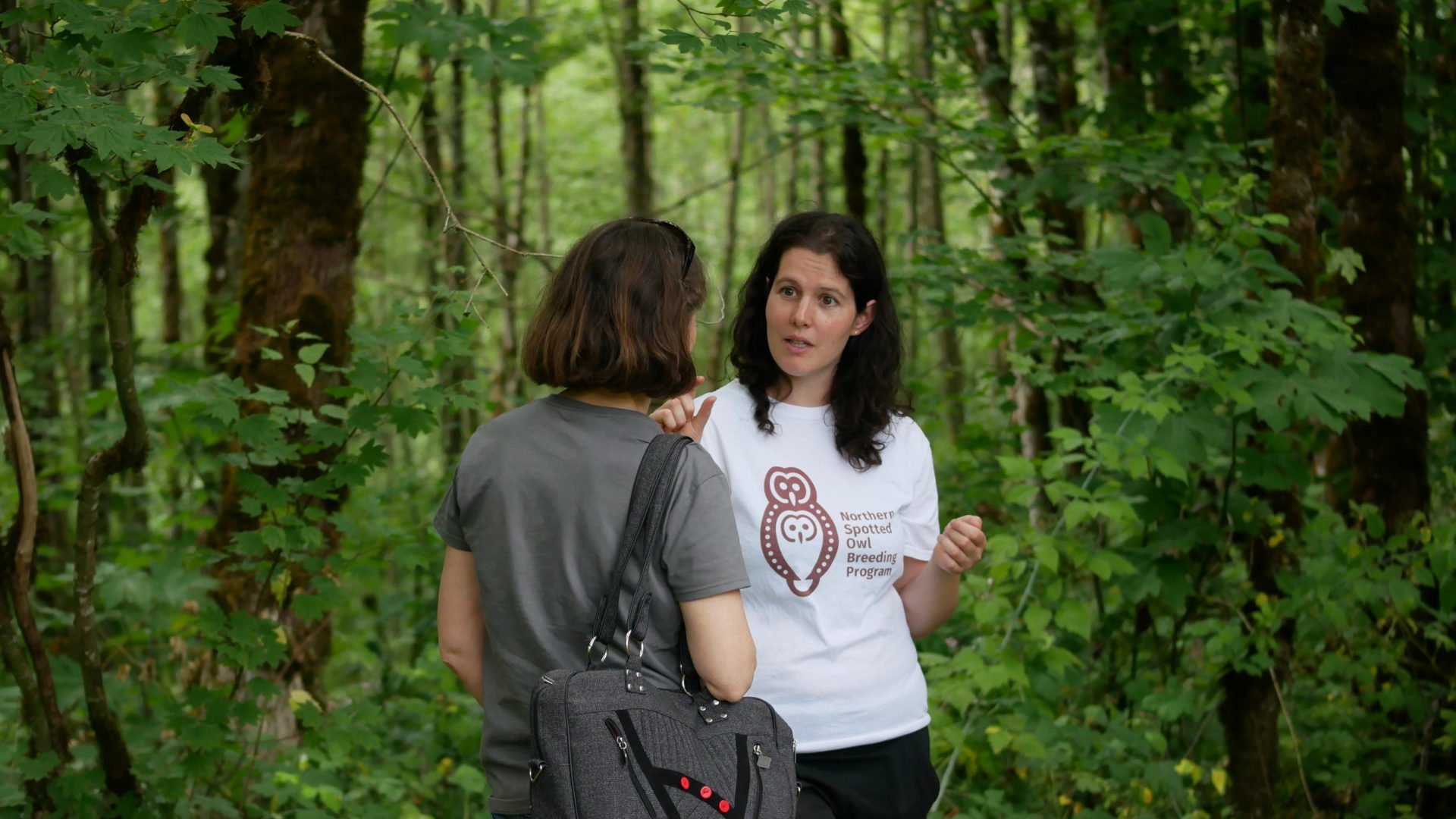
Journalist Sarah Cox interviews McCulligh outside an aviary at the spotted owl breeding facility. Photo: Carol Linnitt / The Narwhal

A rat bred for food at the spotted owl breeding facility. Photo: Carol Linnitt / The Narwhal
McCulligh said on the phone that she’d be happy to offer a tour but couldn’t speak to journalists without permission from the B.C. Ministry of Forests, Lands, and Natural Resource Operations. That ministry, it turned out, was both in charge of spotted owl recovery efforts and responsible for issuing permits to log in spotted owl habitat.
Trolling through the breeding centre’s Facebook page I had spotted an ad for the centre’s annual pub night “Meet the Team” fundraiser at the Townhall Public House in Coquitlam, a former mill town. A $25 ticket procured me a pub grub dinner, a glass of wine and, I hoped, a sighting of the program’s government manager.
In the wood-walled pub, built to service millworkers, was a screen with rotating black and white photographs of old-time loggers standing on planks felling old-growth trees the girth of a bus. The photographs had almost certainly been taken in former spotted owl habitat stretching from the Lower Mainland to north of Lillooet, where the species often raised its young in dead tree cavities or “stovepipes” where wind had snapped off treetops. The old-growth canopy afforded protection from predators like the Great Horned Owl and harboured plenty of flying squirrels and packrats, mainstays of the spotted owl diet.
The government manager was nowhere to be seen, but a raffle offered nine tempting prize packs displayed on thick wooden bar tables. One prize was a tour of the spotted owl breeding facility. I bought 10 numbered raffle tickets and stuffed the jar.
The next morning, an e-mail from McCulligh informed me I had won the tour package. I could have the tour anytime I wanted, she said, but she still wouldn’t be able to grant me an interview without permission from the ministry.
Three weeks later, permission finally secured, I waited for McCulligh outside locked gates at a bucolic property nestled in rolling green hills.
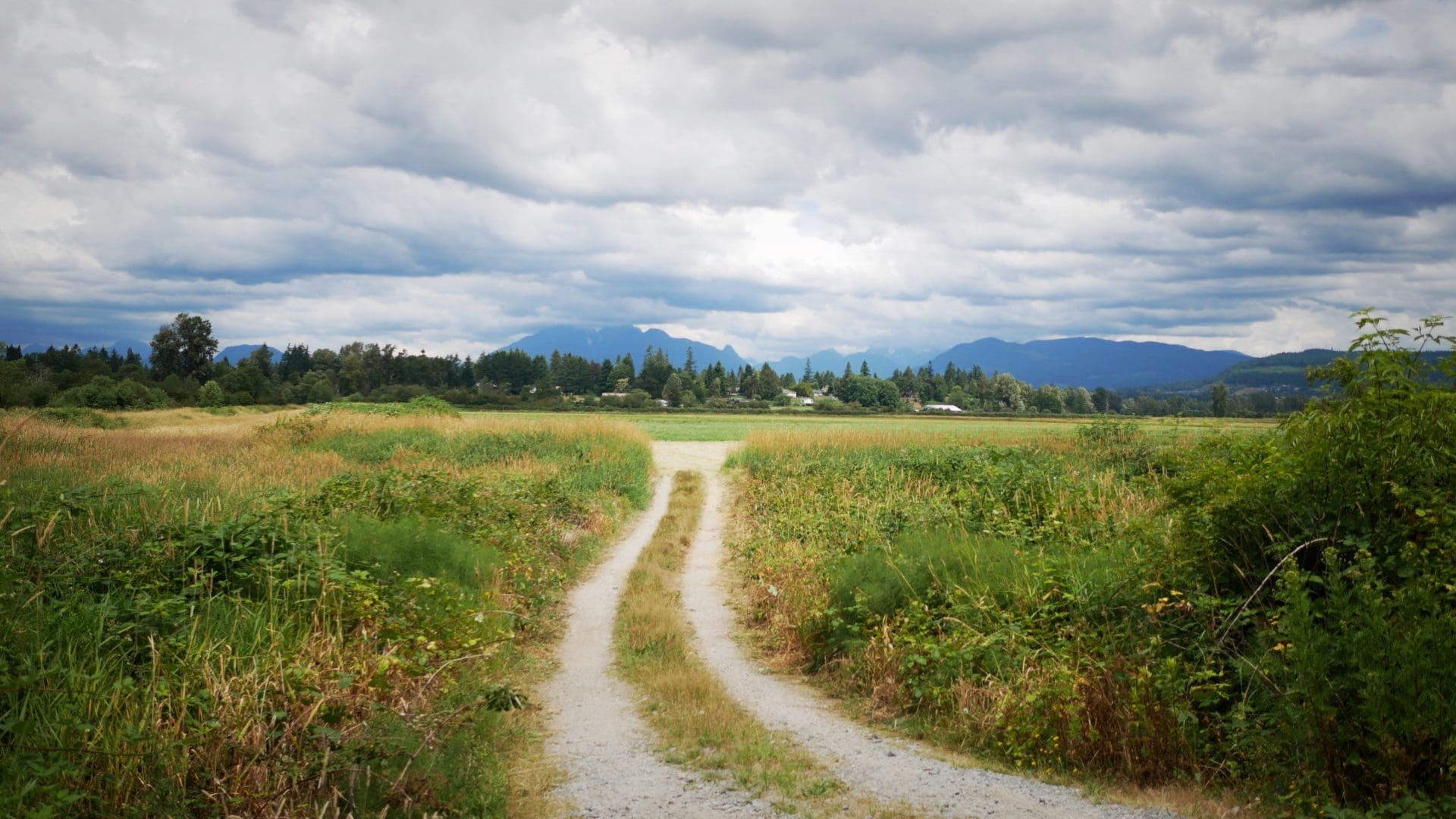
A pastoral scene near the captive breeding facility in Langley, B.C. Photo: Carol Linnitt / The Narwhal
McCulligh, a hazel-eyed, fast-talking millennial, grew up in Ontario dreaming of raising endangered species to release into the wild. But it was the iconic large mammals she envisioned, not avians. She was largely unfamiliar with spotted owls until 2012, when a friend sent her a posting for an unpaid internship at the breeding centre just as she completed a degree in wildlife biology at the University of Guelph. She loved working with spotted owls so much she stayed.
“Those birds are unreal to see in person,” she said. “It’s really special. I feel so lucky to work with them…And then on a grand scheme level I’ve learned in this job that it’s not about the species. It’s about the ecosystem and conservation in general. You can save one species and save so many other species because it [the spotted owl] is an umbrella species and an ecosystem indicator. It’s not just about the spotted owl. It’s about the entire Pacific northwest ecosystem — the coastal region at least.”
We parked beside a handful of trailers brought in by the B.C. government as part of its initial $450,000 investment in infrastructure for the breeding enterprise. Outside, an intern scrubbed plastic cages for future owl food — 350 to 400 mice and rats housed in a trailer that sounded like a pet store on steroids, humming with scuffling and squeaks. A dozen teeny mice, born only hours earlier, were so translucent we could see milk in their bellies.
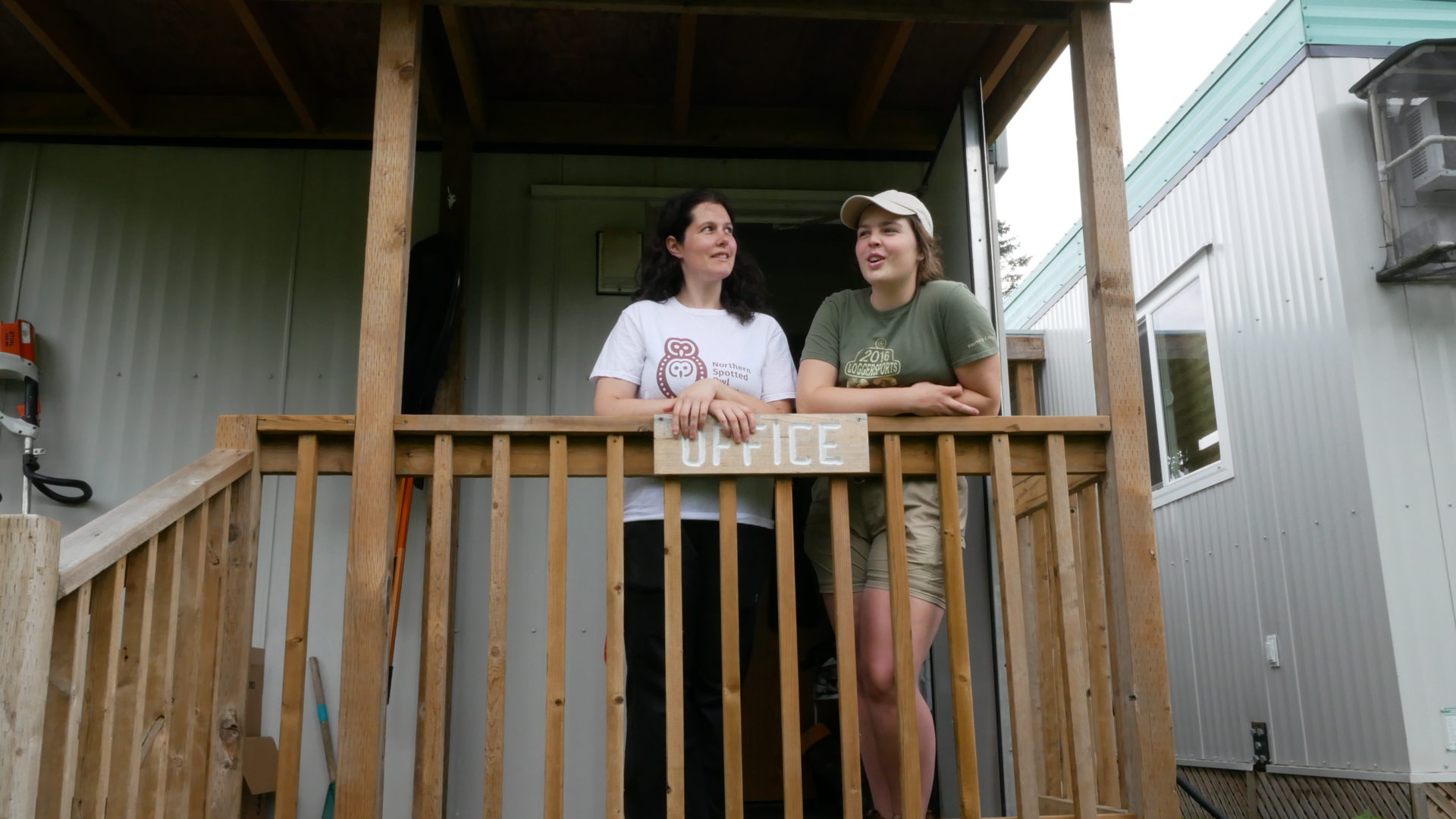
McCulligh and her colleague at their trailer office. Photo: Carol Linnitt / The Narwhal
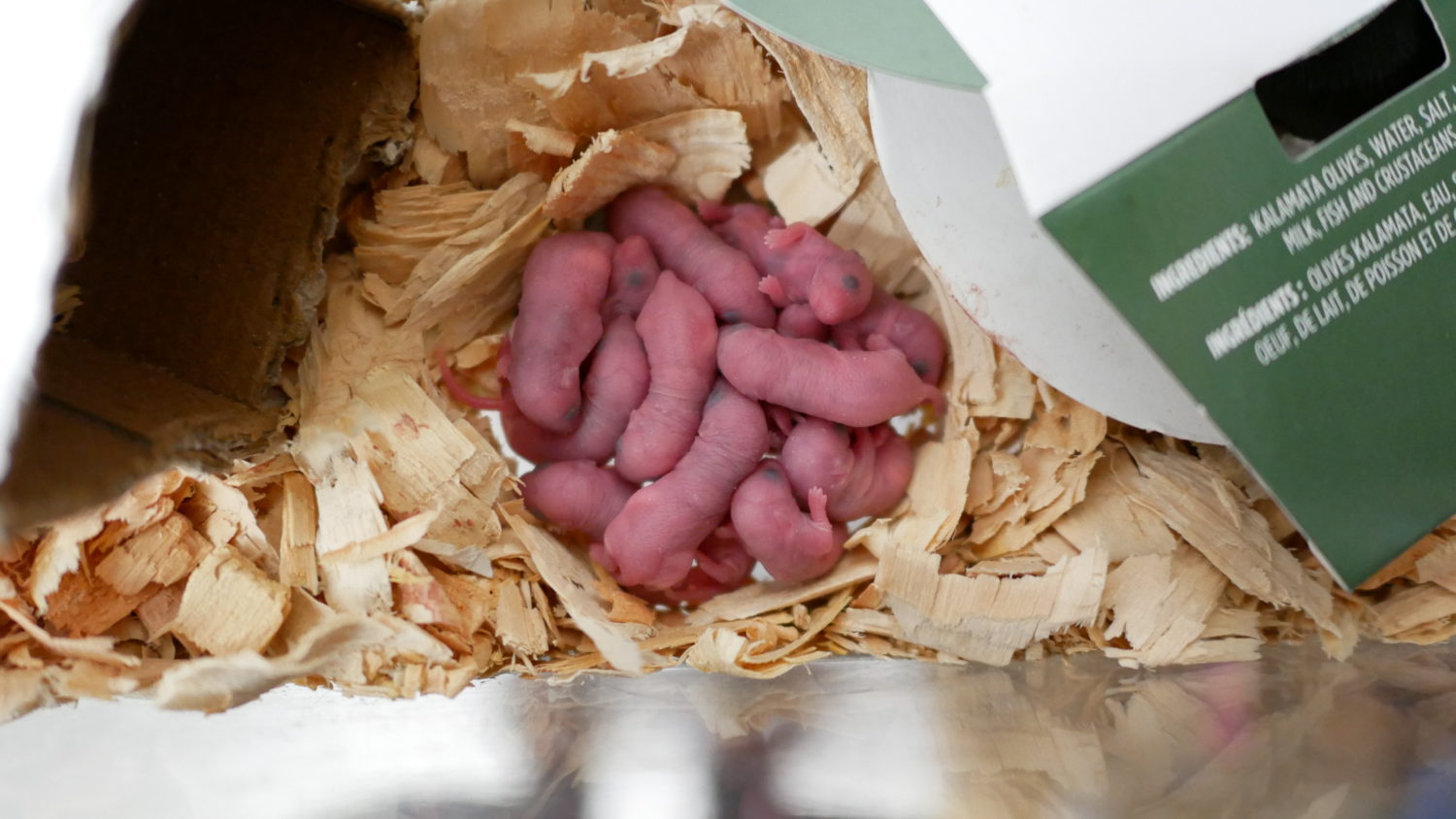
Translucent baby mice at just a few hours old. Photo: Carol Linnitt / The Narwhal
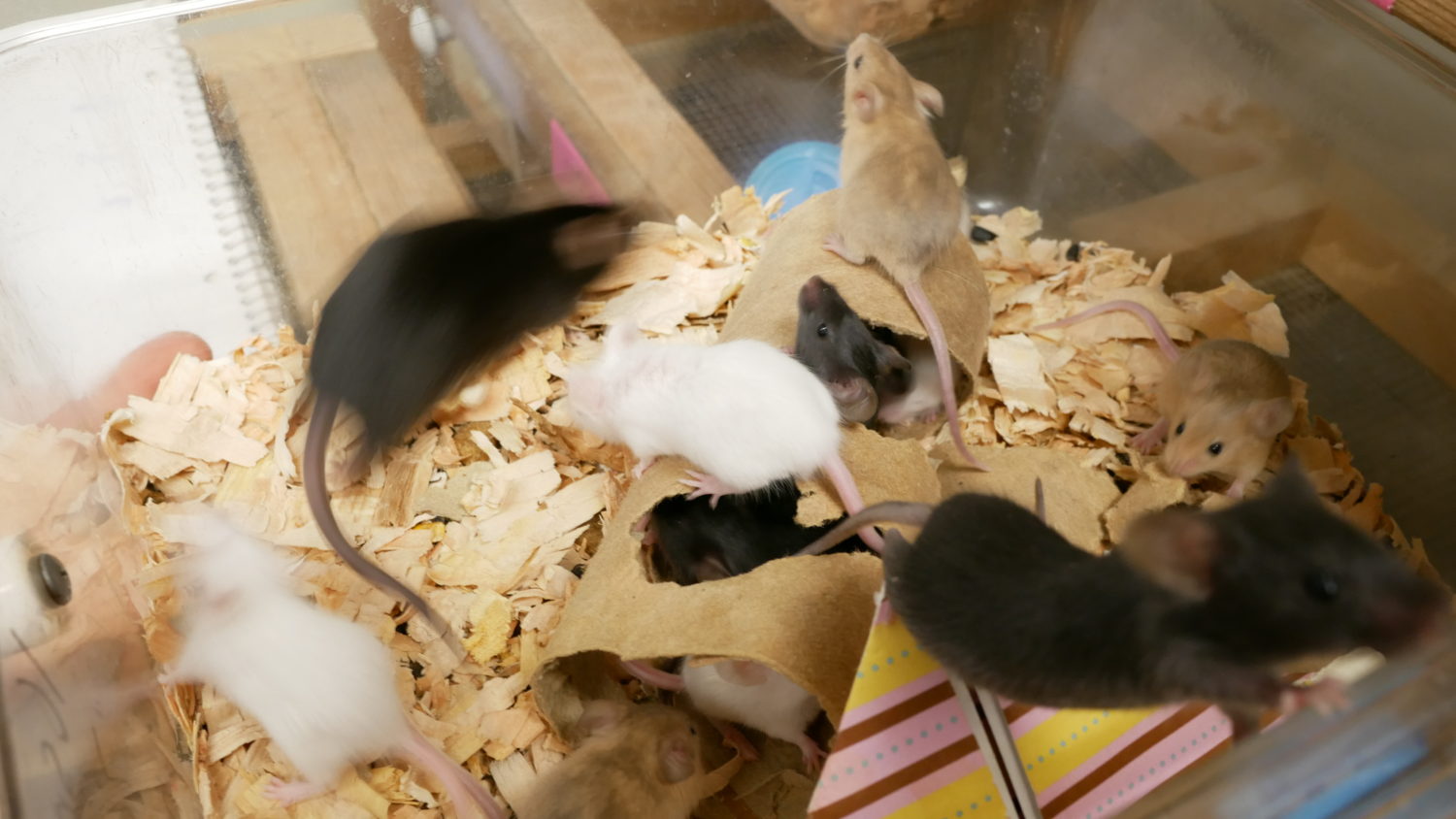
Rat feed for the spotted owls. Photo: Carol Linnitt / The Narwhal
The owls reside in treed aviaries, each separated by latticework and guarded by electric fences to ward off weasels and raccoons. Mindful not to disturb them, the only breeding owl aviary we stopped at was the one belonging to Oregon, the unflappable male rescued as a chick in his namesake state.
Oregon roosted high on a snag, occasionally preening his mottled chest feathers, staring straight past us. Every so often, he emitted a gentle, cooing hoot.
He shared his aviary with his prospective mate, captive-born Skalula, camouflaged among the branches.
“They’re not bonded yet,” said McCulligh. “They hang out and I think they’re really close to being bonded.” Bonding indicates a pair has copulated and produced eggs, she explained.
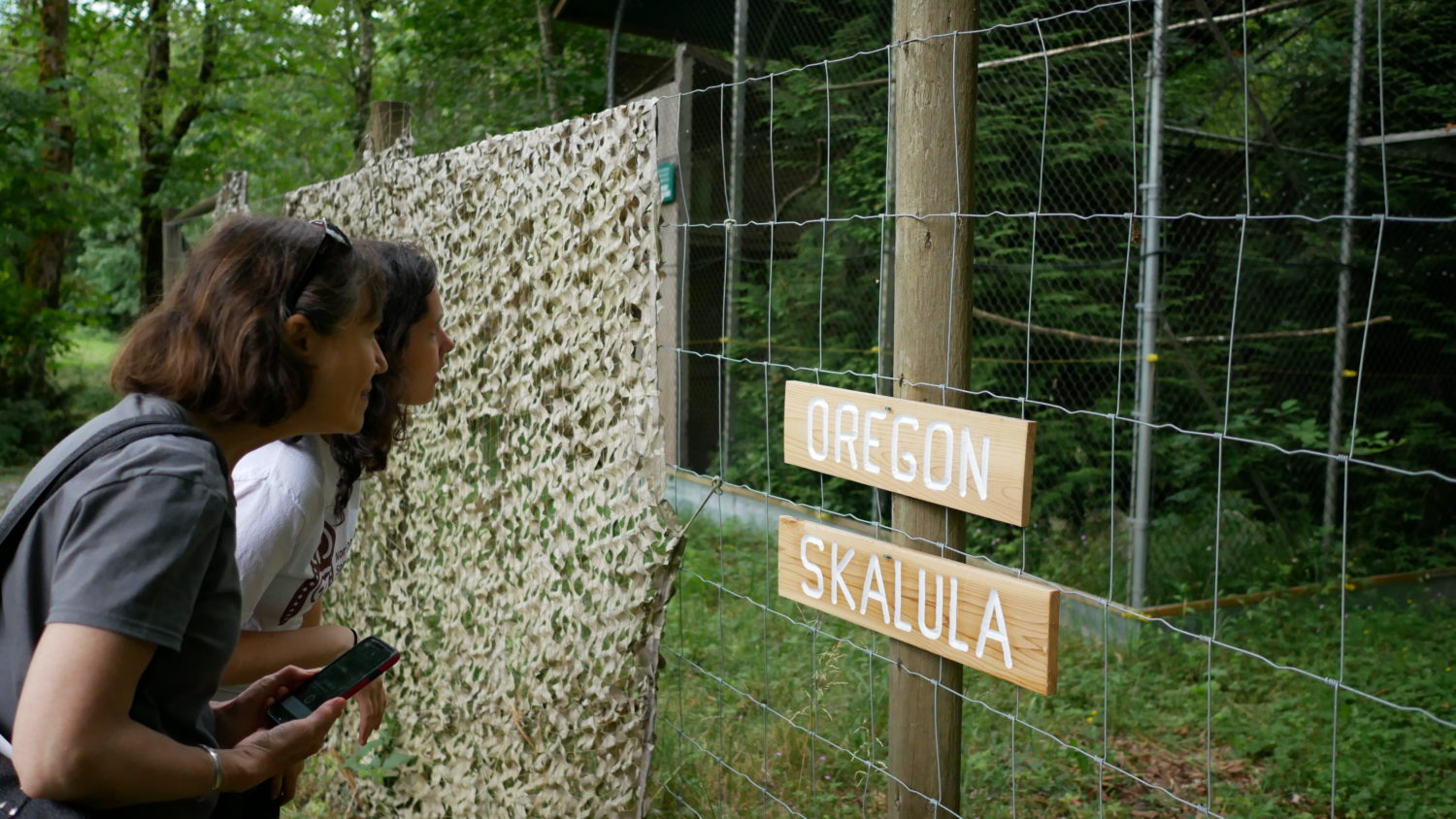
Cox and McCulligh search for spotted owls, Oregon and Skalula, in their quiet aviary. Photo: Carol Linnitt / The Narwhal
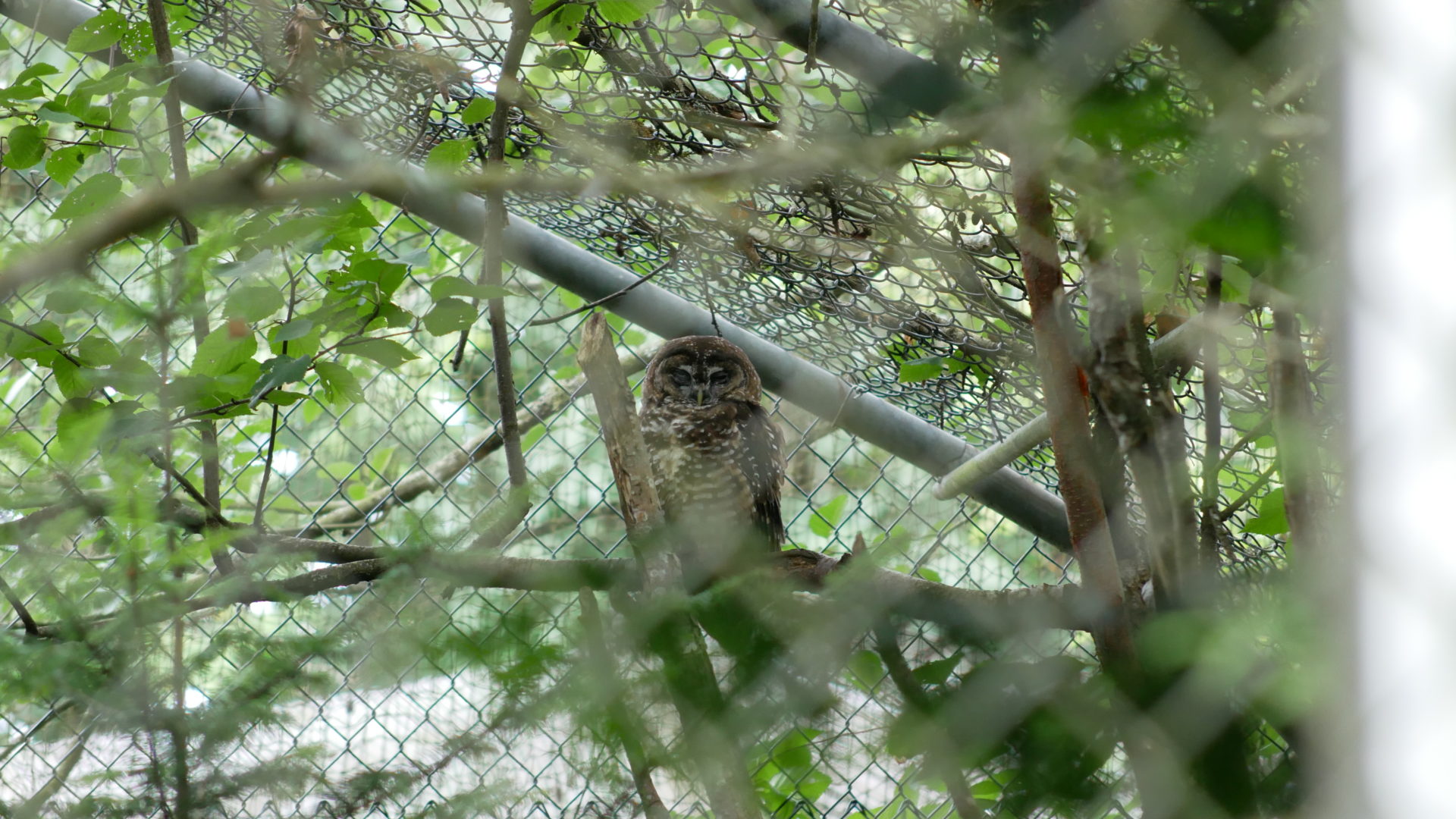
Oregon, a northern spotted owl, in his aviary at the breeding facility. Photo: Carol Linnitt / The Narwhal
The centre’s original plan was to release spotted owls into the wild starting this year. But those plans are now on hold, in part because the centre’s four bonded pairs are very slow to reproduce. There’s only a 25 per cent chance that an occasional egg will be fertile and an even smaller chance the spider-like embryo inside will have a heartbeat eight days after conception.
Spotted owls usually mate for life, but courtship — at least in captivity — can stretch over years and females are choosy about their mates. Shania, the first chick born in the program in 2008, to parents Einstein and Shakkai, spurned the first two males that staff placed in her adjoining aviary, connected by a tunnel.
Only after two years of sharing space with her third suitor, a young dominant male named Scud, did Shania finally accept his advances. At first the owls sat beside each other on a branch, like shy teenagers at a school dance, and preened each other’s feathers. Later, Scud brought Shania euthanized mice and rats from his feeding tray to demonstrate his provisionary skills. When Shania finally accepted his prey delivery staff knew they were on track. They grew even more excited when they saw Shania pulling belly feathers in preparation for incubating an egg. The bonded pair is now the centre’s most productive, producing fertilized eggs that hatched in 2016 and 2017.
Outside of breeding season staff sometimes put live rodents in flower box-like “mouse arenas” to give the owls a chance to hone their hunting instincts.
Cameras in nest boxes monitor copulation — five times one night for one pair during breeding season, and none at all for four-year old Jay and one-and-a-half year-old Bella, whom McCulligh described as the cutest spotted owl pair you’ll ever see. “They’re always hanging out together and will follow each other around. They’re very, very attached to each other but they never copulate. They didn’t lay eggs. Nothing.”
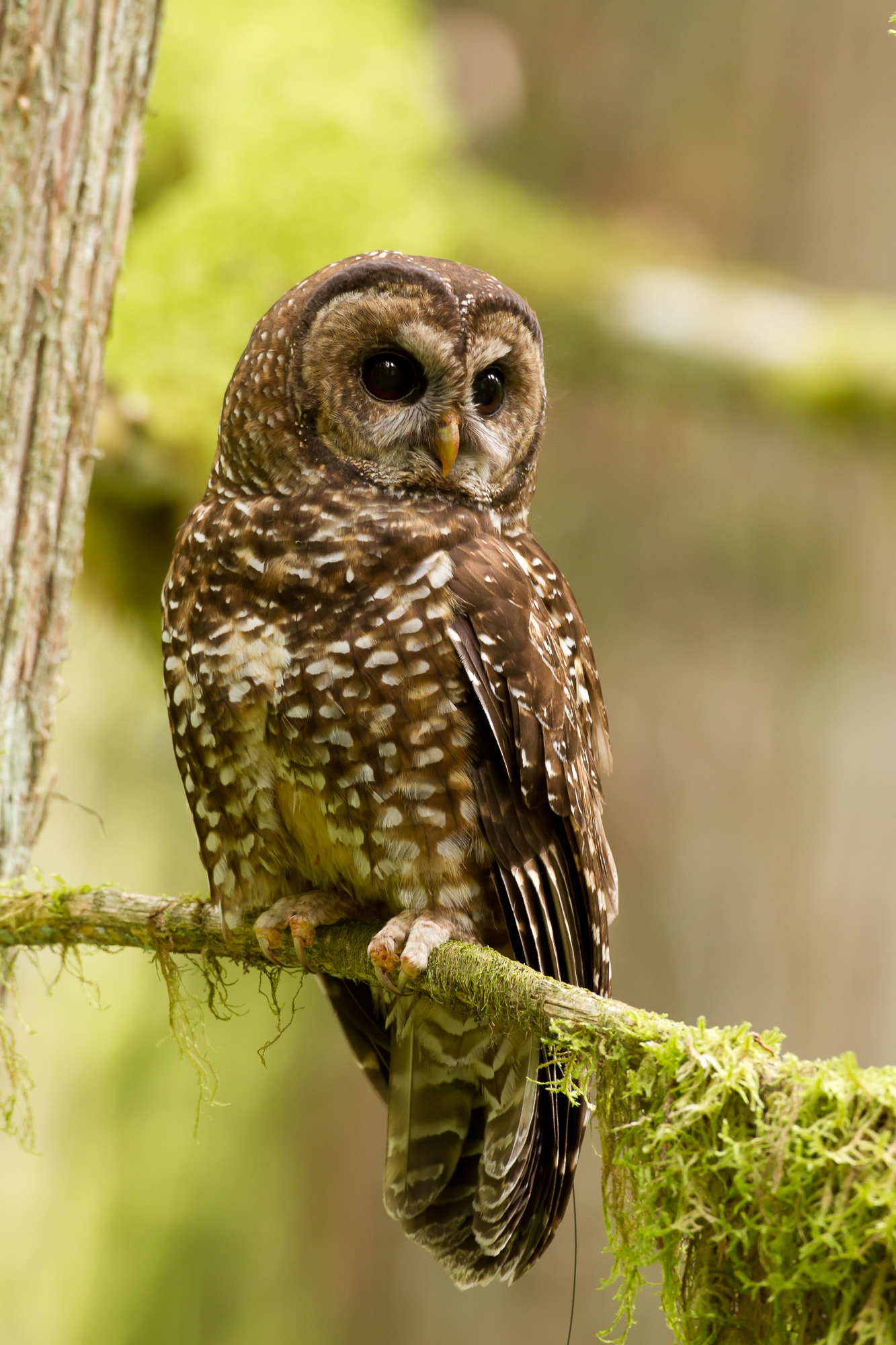
A juvenile spotted owl takes up temporary residence on its dispersal, Cayoosh Creek near Lillooet, B.C. Photo: Jared Hobbs

An adult female Northern Spotted Owl found in a nesting stand near Hope, B.C. Photo: Jared Hobbs
In an effort to boost sperm counts, selenium-rich sardines are included in the diet of rodents bred at the centre. Biologists have even pruned feathers from the captive females’ vents — the only “out door” on the bird — in an effort to allow “greater opportunity for fertilization,” according to Ian Blackburn, the B.C. government manager in charge of the spotted owl breeding centre.
“The program has had its challenges,” Blackburn said in a phone interview when I finally caught up with him. “Our assumption of when we thought owls would start to breed was that by age three they would be fully functioning breeding birds. And this was proven to be wrong in the captive sense, or at least at the captive breeding centre.”
Some captive female spotted owls at the centre don’t breed until they are eight or nine, while one male didn’t copulate and produce a fertile egg until he was 10, said Blackburn, a wildlife biologist who coordinated the spotted owl breeding centre until five years ago. “We’re kind of perplexed.”
At first biologists took a hands-off approach to egg laying and hatching, believing, said Blackburn, that the “owls knew how to do it better than we do.” But in 2011, after discussion with zoos, they decided to artificially incubate the eggs. “Eggs were being broken or disappearing altogether because the female ate it,” Blackburn explained. “That’s your precious commodity, that egg. That was the turning point.”
Despite the slow progress, McCulligh and Blackburn remain optimistic about the breeding program, pointing out that the centre has met its first goal of increasing the population from four owls to 21. Most of the breeding owls are young and chicks born next year could be released after their first winter, Blackburn said, noting, “we’re still waiting for that bumper crop to show up.”
Hopes were buoyed this April when a ninth chick, Bridget, hatched at the breeding centre. Unlike chickens, when spotted owls are born “they can’t stand up,” McCulligh said. “Their eyes are closed. Their ears are closed. They kind of just wobble and roll around a lot.”
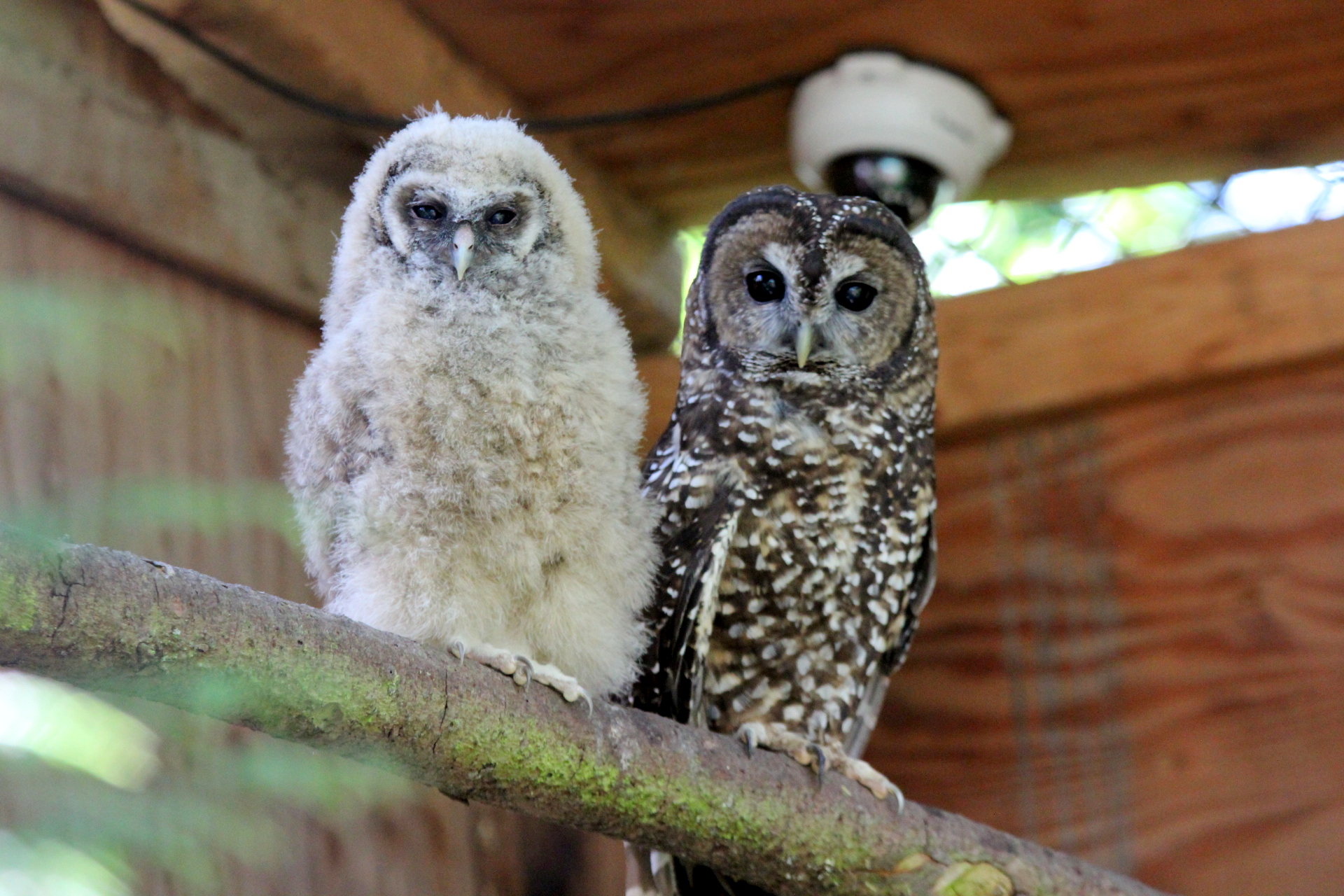
A spotted owl and youngster at the breeding facility. Photo: Northern Spotted Owl Breeding Program
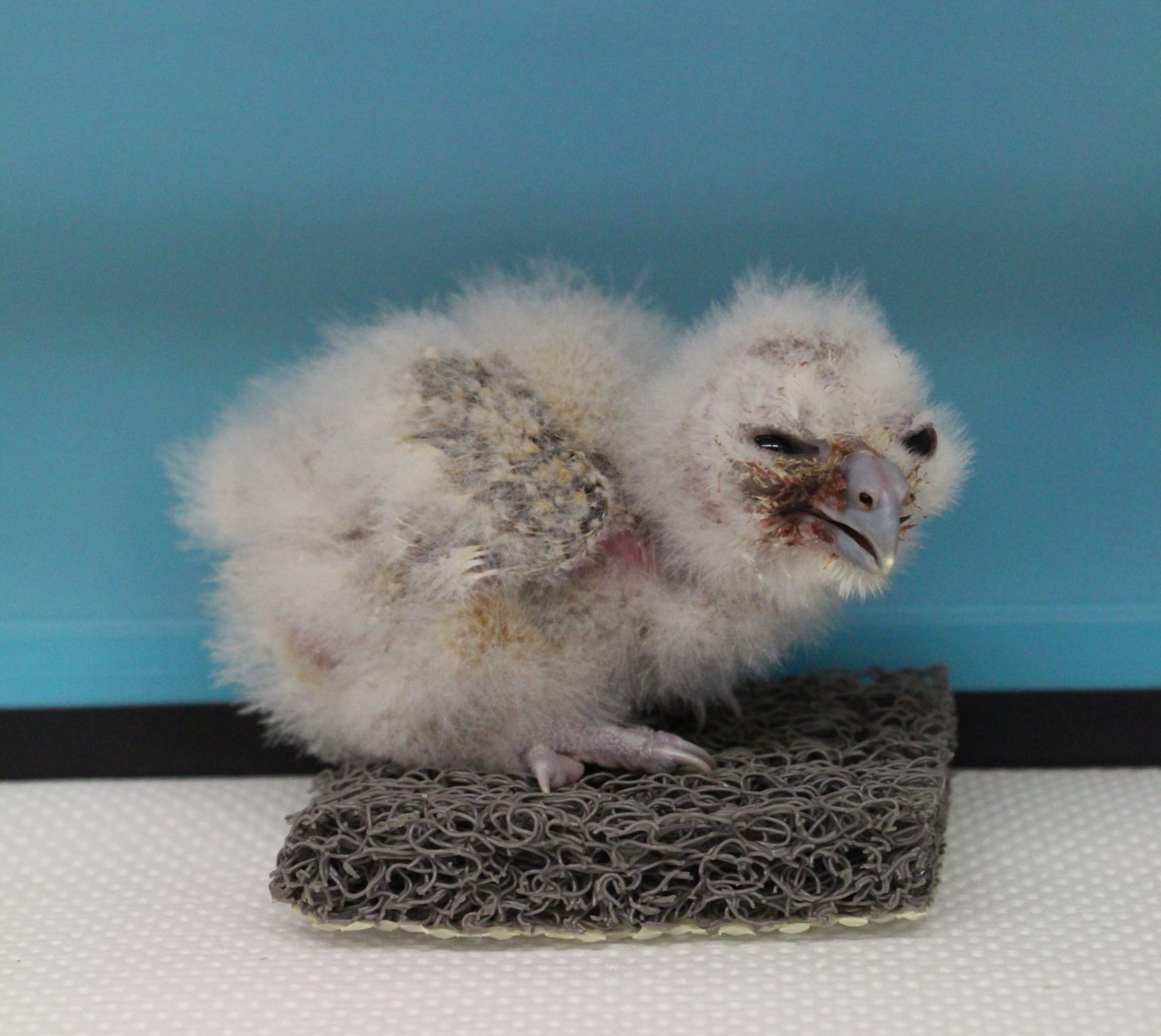
Bridget, on her return trip at 10 days old. Photo: Northern Spotted Owl Breeding Program
Clad in sterile gowns, masks and gloves, McCulligh and other centre staff wiped the hatchling’s waste and monitored her constantly to make sure her spindly legs didn’t splay. They weighed her four times a day and examined the chick thoroughly every 24 hours to ensure good health.
When the owlet was 10 days old, she was removed from the Artificial Inc. lab and given to foster parents in the hopes of encouraging her biological parents to lay another egg. Just as the biological parents had been none the wiser when staff replaced Bridget’s egg with a sensor egg made in a laboratory (store-bought chicken eggs are sometimes used as a substitute), foster parents Scud and Shania didn’t seem at all perturbed to find an unexpected hatchling in their nest box. The new parents immediately shredded rat meat for their charge, nuzzling her with affection.
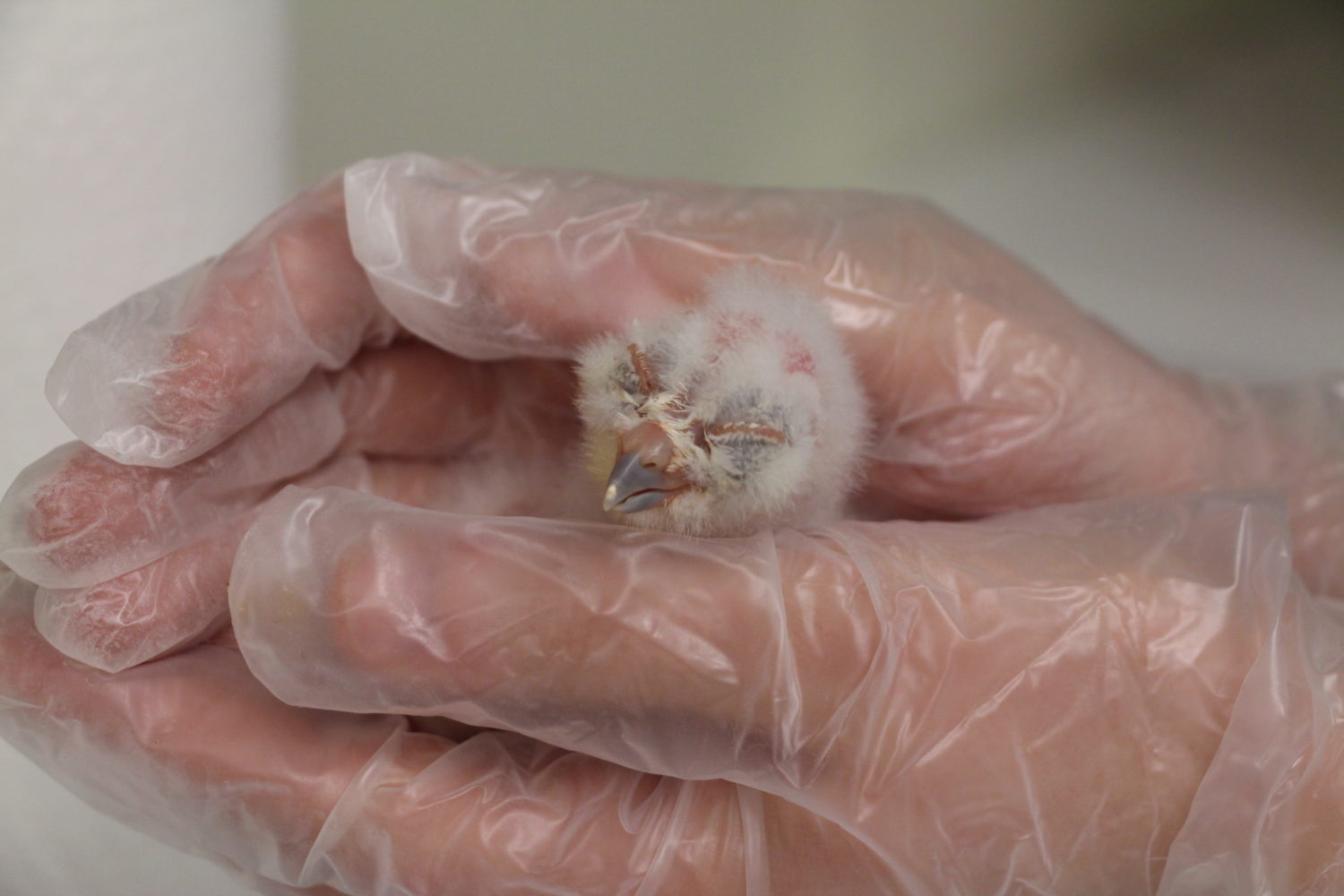
Dante at three to five days old. Photo: Northern Spotted Owl Breeding Centre
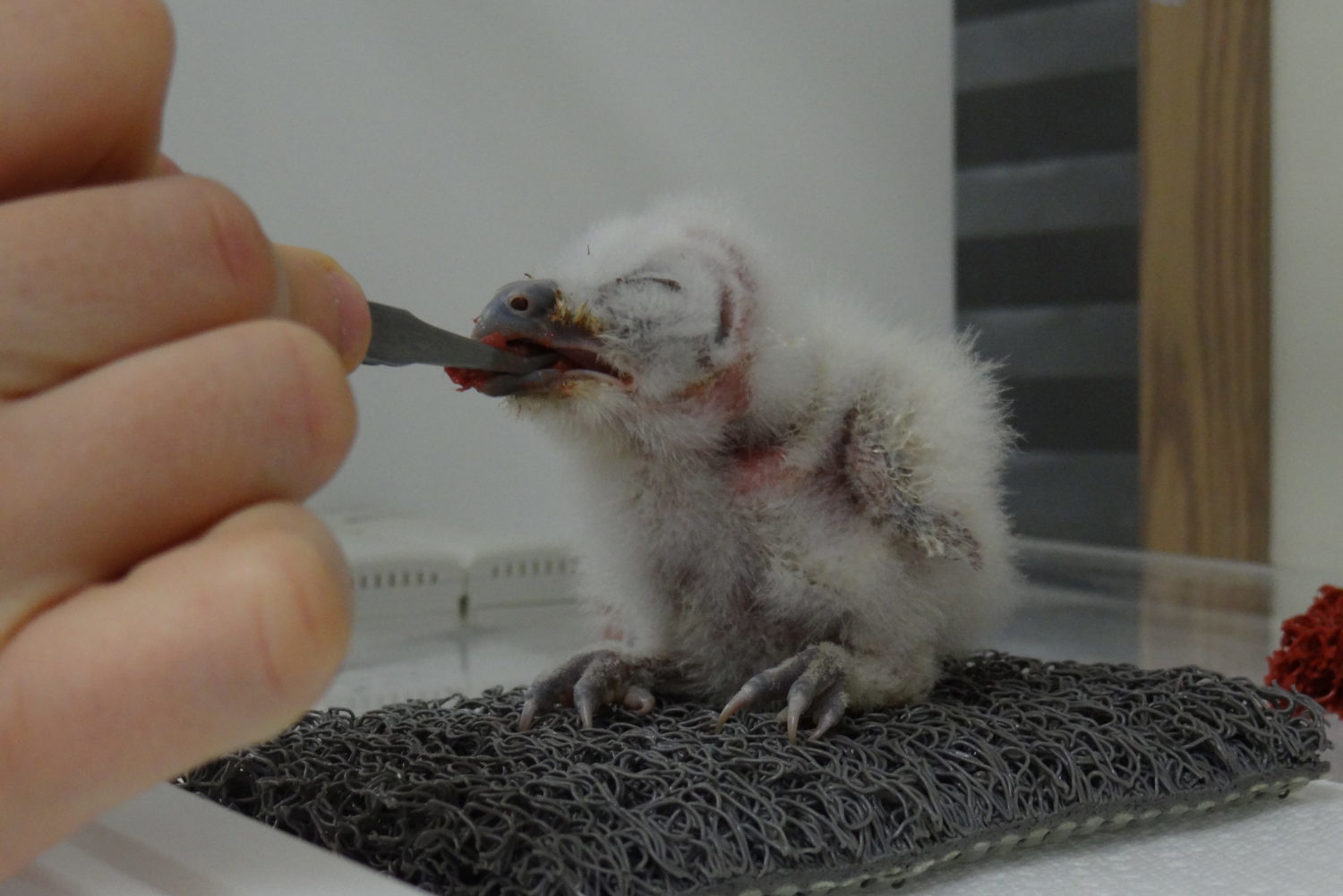
Dante at about 10 days old being fed raw, euthanized rat meat. Photo: Northern Spotted Owl Breeding Centre
“We got one chick,” McCulligh said. “That’s exciting. In five years we have doubled the population. I don’t think you can let discouragement be a word here. It’s a slow build.”
The question of whether the centre’s slow build will ever translate into a viable spotted owl population in B.C.’s wild concerns wildlife biologist Jared Hobbs. Hobbs was a scientific advisor for the B.C.’s spotted owl recovery team from 2002 to 2006. He stepped down when the provincial government decided to focus on captive breeding as a primary plank in its spotted owl recovery strategy while continuing to allow logging in spotted owl habitat, pointing out that B.C.’s recovery strategy was not completely aligned with scientific recommendations outlined in a spotted owl recovery plan.
“In B.C. it’s still completely legal to log a spotted owl nest as long as the owl is not in the nest.”
“I’ve been watching ever since, keeping my finger on the pulse but it’s disheartening,” said Hobbs, also a professional photographer and author of the book Spotted Owls: Shadows in an Old-Growth Forest.
Hobbs said the founder population for captive breeding was notably small and there were challenges with husbandry — for instance, the owls could not learn to forage on their principle wild diet of flying squirrels and packrats. And a new set of hurdles will have to be jumped if captive-bred owls are released into an ecosystem they have never before encountered, lacking training from their parents, he said.
“Am I optimistic that we’ll see a self-sustaining population of spotted owls in British Columbia in the future? No, I’m sadly pessimistic. But I do think it’s possible. Recovery will require that we change the way we manage spotted owl habitat.”
On its website, the B.C. government claims 363,000 hectares is being “managed” for spotted owl recovery. But about half of that habitat is not currently suitable for the species, according to Hobbs, who also points out that just over half of the habitat managed for spotted owls — 190,000 hectares — was already conserved in provincial parks and protected areas.
And that’s not all, because the B.C. government also allows logging in 108,000 hectares designated as wildlife habitat areas for the spotted owl, as long as those areas are managed to ensure two-thirds of the land base retain suitable habitat.
“Much of the area set aside for spotted owl habitat on Crown land is not currently suitable for spotted owls due to previous timber harvests,” said Hobbs.

The Karen Creek clearcut, in a watershed located just east of Hope, B.C., within a Wildlife Habitat Area designated by the B.C. government to preserve Northern Spotted Owl habitat. Photo: Wilderness Committee
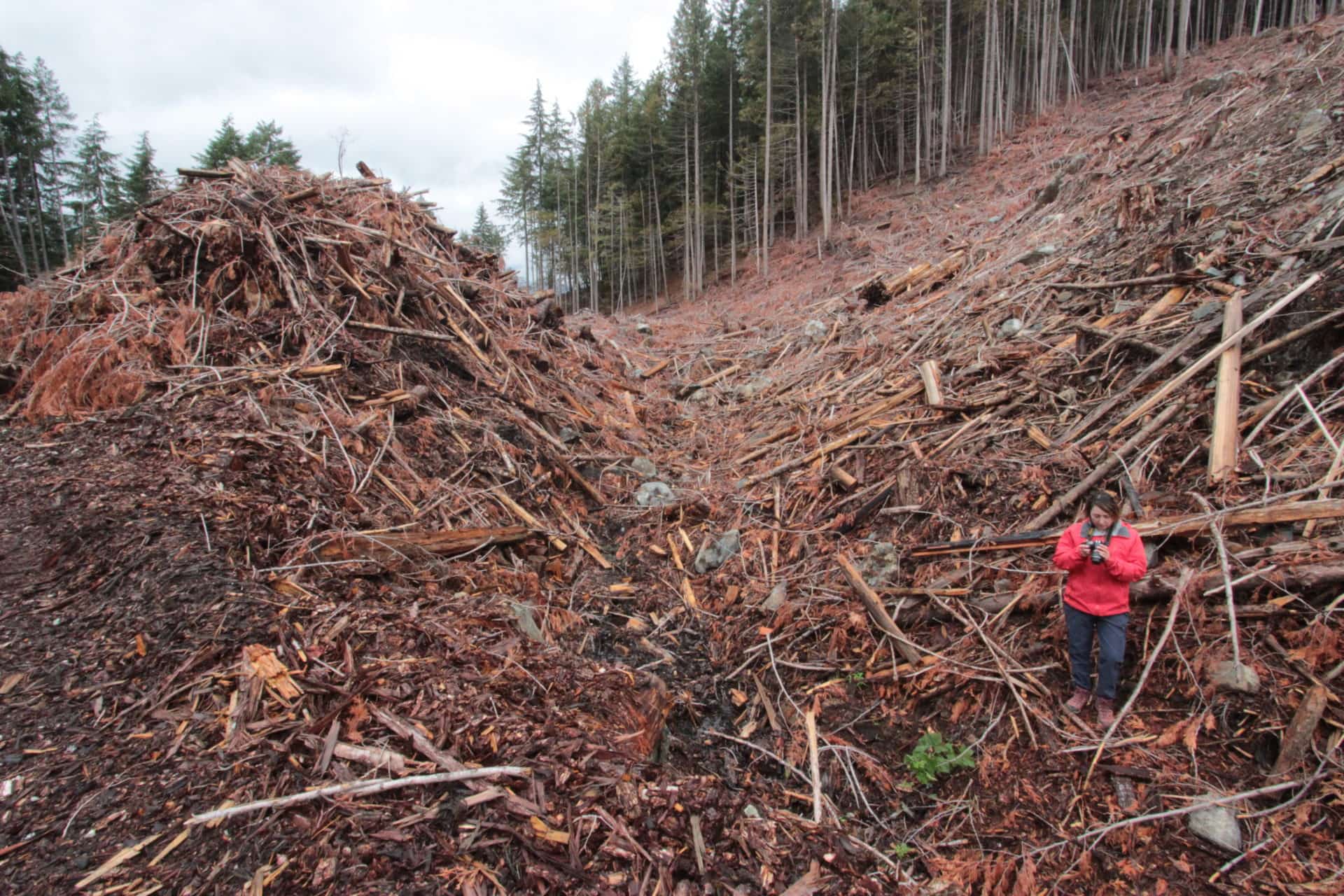
Charlotte Dawe, conservation and policy campaigner with the Wilderness Committee, stands in the Karen Creek clearcut. Photo: Wilderness Committee
Also troubling, the B.C. government allows timber harvesting in 75 per cent of the 51,000 hectares it calls “managed future habitat areas” for the owl, even though it could take hundreds of years for suitable habitat to re-grow. “In B.C. it’s still completely legal to log a spotted owl nest as long as the owl is not in the nest,” Hobbs pointed out.
Recovery efforts are hampered because of a provincial government decision that there be no net loss to timber revenues in any proposed future management areas for spotted owls, said Hobbs, noting, “It’s a challenge to recover spotted owls in B.C. with no net gain to its habitat.”
DellaSala likened the spotted owl to the quintessential canary in a coal mine. The owl is an indicator of a “whole complex ecosystem with all the parts that are in jeopardy,” he said. “This is just one of the parts and it’s telling us we have not done a responsible job of maintaining the old-growth ecosystems upon which the owl and thousands of other species depend.”
When old-growth rainforests are fragmented and clear-cut, “it’s not just the owl, it’s goshawks, it’s murrelets, it’s tree voles, it’s lichen,” said DellaSala, president and chief scientist of Oregon’s Geos Institute. “It’s caribou as you go further inland. It’s salmon. It’s a whole collection of species, it’s the sum of the parts of the ecosystem. And we all depend on that ecosystem for clean air, climate security, clean water and recreation. We’re all in this together and the owl is the symbol of how we overextended ourselves in terms of logging.”
Governments have known for decades that the spotted owl was in trouble, yet they have avoided taking sufficient action to reverse that downward trend. Spotted owls were assessed as endangered in 1986 by the Committee on the Status of Endangered Wildlife in Canada, when only a few hundred remained in the wild.
Ten years later, with the population in steep decline, a listing under the federal Species at Risk Act compelled the B.C. government to develop a spotted owl recovery strategy in 2006. The federal recovery strategy clearly identified the primary obstacles to spotted owl survival and recovery: destruction of old-growth habitat and fragmentation of remaining habitat.
“It’s universally known that the biggest threat to the spotted owl is habitat destruction in old-growth forests.”
Recovery of the species was “ecologically and biologically feasible,” according to the strategy, which set a goal of at least 250 adult owls in the wild.
Only two years later, the Committee on the Status of Endangered Wildlife in Canada noted a “catastrophic” population decline — to just 19 individuals — as even more habitat was clear-cut and fragmented. Juvenile spotted owls were not surviving dispersal, which sent them across clear-cut landscapes where risk of predation was far higher than in the relatively closed canopy of old-growth forests.
“All adults are old and near the end of their breeding age and there is no recruitment of young owls into the population,” the committee reported. “If current trends are not reversed, extirpation will likely occur within the next decade.”
One of the first priorities of the Canadian Spotted Owl Recovery Team was to establish — within a year of its formation in 2006 — the total amount and distribution of recovery habitat. The definition of critical habitat was deemed to be “urgent.”
But 12 years later, critical habitat has still not been identified.
Environmental lawyer Kegan Pepper-Smith called the delay “absolutely shocking, especially considering it’s universally known that the biggest threat to the spotted owl is habitat destruction in old-growth forests.”
“So long as we see this essentially unfettered destruction of old-growth habitat we’re going to see species like the spotted owl make their way towards extirpation if not extinction,” said Pepper-Smith, a lawyer with Ecojustice, which in 2004 launched a legal case seeking an emergency order to protect spotted owls under the federal Species At Risk Act. The case was dropped when the recovery plan was announced.
“We need a re-assessment of the way we prioritize timber supply of old-growth forests and the relation to protecting these species that have relied on this habitat for millenia,” Pepper-Smith told The Narwhal.
And now there is another wrinkle in the prospects for northern spotted owl recovery. Bigger, more aggressive barred owls are competing with the spotted owl for habitat, after migrating west of their historic range.
Barred owls can thrive in fragmented habitats and don’t depend on old-growth rainforests like their spotted owl cousin. “Barred owls aren’t choosy,” noted Blackburn. “With spotted owls excluded from these fragmented landscapes barred owls have just moved right in.”
“If there’s a breeding pair of spotted owls they can defend the territory. But if one mate disappears that individual bird has a hard time defending the territory. There’s just no other spotted owl around to come and pair up with it and defend it. Eventually they get pushed out.”
Just as the B.C. government shoots wolves from helicopters to try to save endangered caribou, the B.C. government and U.S. state governments also shoot barred owls to give spotted owls a chance. Over the past decade, the B.C. government has removed 189 barred owls from spotted owl habitat; 138 were captured and relocated and 51 were shot at active or recently occupied spotted owl sites, according to Blackburn.
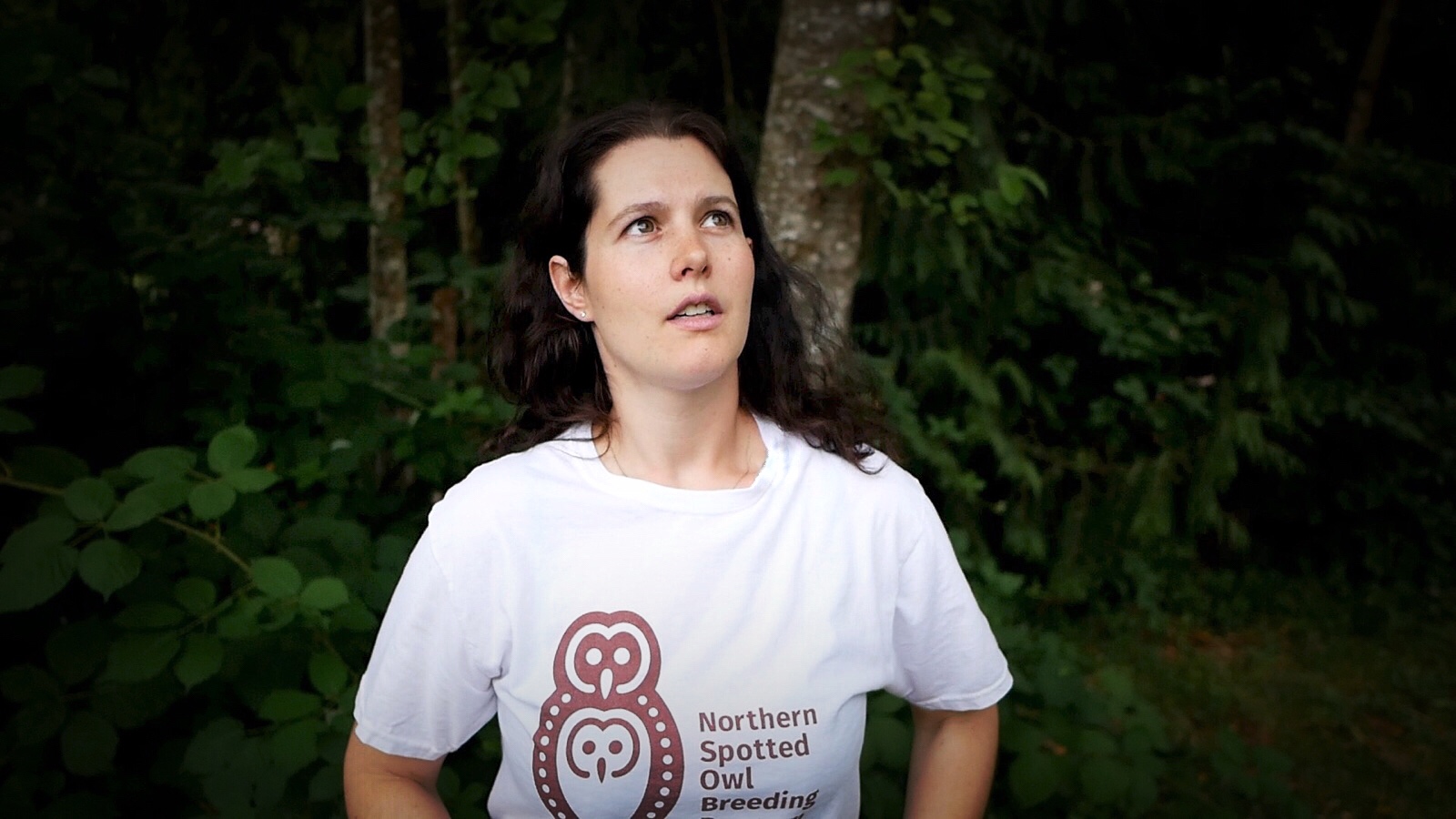
Jasmine McCulligh. “In five years we have doubled the population. I don’t think you can let discouragement be a word here. It’s a slow build,” she told The Narwhal. Photo: Carol Linnitt / The Narwhal
At the same time, the provincial government also keeps two breeding pairs of barred owls at the spotted owl centre and hatches their eggs in incubators. Barred owls are proving to be prolific breeders in captivity compared to spotted owls, and most of their eggs are fertile. Over the past several years, the centre has released 10 captive-born barred owls with GPS backpacks to track their flight and progress — to practice for the eventual release of spotted owls, Blackburn said. One artificially incubated barred owl named Forrest accompanies breeding centre staff on school visits.
Barred owl captive breeding offers an opportunity to experiment with techniques such as mending cracks in eggs with glue, which could prove useful for spotted owl breeding, according to Blackburn. The centre has also placed barred owl babies with spotted owls to assess parenting skills. “We put in some barred owls for them to practice on and they all did great, awesome parenting,” he said. “It was quite interesting to see how immediate it was. Their mate would come and bring food immediately to the barred owl baby.”
Hobbs said the spotted owl needs governments to set the stage to allow it to recover.
“We need to give them the habitat they need to persist so they can co-evolve with barred owls and learn how to out-compete this owl or co-exist with it. And if we can do all that then we may have spotted owls in the future.”
DellaSala credits the spotted owl with teaching him an important lesson in life as he spent time climbing nest trees, examining what they ate, and learning about old-growth rainforests: that humans are part of ecosystems and depend on them.
“They’re one of a kind, they’re remarkable. It just saddens me when we don’t appreciate life.”
This report was produced with financial assistance from the Unchartered Journalism Fund.
